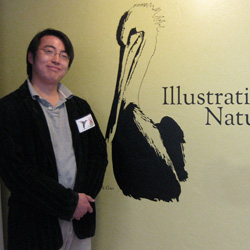|
The Moth Wars
Two years ago, a bug set off a nasty clash in California. Daniel Strain revisits the battleground. Illustrated by Kirk Guo and Christie Newman.

Illustration: Kirk Guo (people) and Christie Newman (moth)
The moth's American story may have started like this: Its larvae travelled by boat, accidental hitchhikers on a fruit shipment. Like immigrants in the days of Ellis Island, the grubs rode out the cold and damp of the voyage with leaves wrapped around them like blankets. Crawling from their cocoons, the moths found themselves in California, gold hills stretching into the distance.
In 2006, a retired entomologist trapped a lone adult—a drab moth no bigger than your thumbnail—in his Berkeley backyard. This bug set off a chain of events that split California in two: pesticide-wary citizens on one side and the state government on the other.
The troublesome insect was an Australian native and known agricultural pest called the light brown apple moth (Epiphyas postvittana). Since debarking from that boat, its populations had grown undercover throughout the San Francisco Bay Area and in Monterey and Santa Cruz counties to the south. The U.S. Department of Agriculture and the California Department of Food and Agriculture (CDFA) moved to squash them in their tracks. They enlisted crops dusters to douse urban areas, like the city of Santa Cruz, with a pesticide based on the insect's natural sex pheromones.
The CDFA swore the spray was harmless, but toxicologists hadn’t tested it for health or environmental safety. That worried Santa Cruz residents like Paulina Borsook. In May 2007, she was emerging from her own cocoon of caring for her elderly mother when what she calls the “moth wars” began. “I was just beginning to crawl out and reclaim my life, and then the state of California decides it wants to try to kill me,” she says.
Dozens of front page articles and TV spots billed the clash as “moth of mass destruction versus public health menace,” Borsook says. Local government support for the state tanked. In 2008, hundreds of people staged a march across the Golden Gate Bridge to protest the CDFA’s actions. The agency abandoned its aerial campaign less than one month later in June.
“If you asked why this happened, it’s the mindset, which, actually, has always been here,” Borsook says. “This is the heart of the heart of blue state California. What makes you think we’re going to put up with this?”
But two years later, mounting evidence has shed doubt on both the state and opposition’s stances. Prominent scientists and a federal report argued that the light brown apple moth might not be the pest to end all pests, after all. They also questioned whether the CDFA stood a chance of eradicating it in the first place. Anti-spray activists charged that the agency’s pesticide was littered with known toxins that made hundreds of people sick following initial aerial treatments in Santa Cruz and Monterey. But most toxicological studies now suggest otherwise. As the dust clears, there isn’t a David or Goliath—just a bunch of people holding slingshots.
The light brown apple moth has since spent its days meandering the Pacific coast. But, for many like Borsook, the calm is temporary. As the state gears up for a second round of assaults, the moth may once again find itself at the center of a rough-and-tumble California.
Trouble in ecotopia
Borsook, with bushy gray hair, has bee-like energy. She talks rapid-fire and emphasizes her points by slapping the table with her palm. She was a technical writer in the infancy of Silicon Valley. Decades ago, she moved to Santa Cruz—or as she calls it, “the people’s republic of ecotopia”—to escape the pollution of San Francisco. As an independent activist and member of the group Stop the Spray. Borsook spends her days mailing letters to politicians and camping out in libraries.
 Photo: Daniel Strain
Photo: Daniel Strain |
Paulina Borsook stands on the steps of City Hall in Santa Cruz. In December 2007, she and hundreds of other activists gathered here to voice their outrage over aerial spraying of the light brown apple moth. |
|
“I hadn’t seen this type of public outrage since the height of the anti-war movement in ’68, ’69, where people were that outraged, that out in the streets,” she says.
To the CDFA, the light brown apple moth wasn’t an innocent wanderer but a fugitive on the run. The bug trespassed into New Zealand in the late 1800s. In the 1960s through 1980s, it spoiled an average of 8 percent to 26 percent of the nation’s apple crops, according to a recent report in the journal California Agriculture. The moth wasn’t the sort of houseguest the CDFA wanted around, nor did California's trading partners, says Marshall Johnson, an entomologist at the University of California, Riverside.
The CDFA planned to crush the bug with a strange boot—the pheromone scent that male moths inhale while tracking down females. The agency was going prevent males from ever finding mates by bombarding them with sexual noise. The pesticide, called Checkmate, wasn’t even a pesticide. “The only way you can kill an insect with a pheromone is if it drowns in it,” Johnson says.
The CDFA—which declined to participate in this story—organized town-hall meetings to make its case but found them filled with steaming citizens. “I’m sure the ag commissioner brought his own armed guard with him,” says Mike Rotkin, a Santa Cruz city councilman. YouTube was peppered with activist videos, some satirical and some vitriolic.
Support from many local growers similarly wilted. California Certified Organic Farmers, which advises about 2,000 Californian farmers and food manufacturers, originally accepted the CDFA’s plan but withdrew its approval in March 2008. Many of the organization’s members were up in arms over the state’s stringent quarantines, says policy adviser Zea Sonnabend.
The CDFA inspected farms and nurseries in Santa Cruz County, often holding up shipments—mostly berry and fruit crops—when it suspected infestation. Teresa Aquino, a bamboo and exotic plant nursery owner, had a “find” on her property in 2007. The state told her she could either bathe her stock in pesticides or close. She chose to pack it in. After raising hell with the USDA, Aquino reopened her nursery weeks later on a milder insecticide regimen but, she says, the fun was gone. She stopped growing exotics—more prone to moth attacks—because she couldn’t afford to close again.
“It’s one thing to go through all this trouble and exposure and danger in some cases for something that seems really important and worthwhile, and this was not,” Aquino says.
The CDFA was only able to conduct three spray treatments, two in Monterey County and one in Santa Cruz County in September through November 2007. In response to a lawsuit filed by the city of Santa Cruz, a county Superior Court judge nixed further sprays in April 2008 pending an environmental impact report. Such a report would include a bevy of tests to demonstrate the need for and safety of the plan.
Borsook calls the victory “inconceivable.” “I was sitting there when we got the news and I had tears in my eyes,” she says.
Public health menace
Many men and women played a role in that victory, Borsook says. According to Santa Cruz City Councilman Tony Madrigal, his contribution was a good chant for public protests. His favorite: “Our lungs. Our choice.”
To protect the manufacturer’s trade secrets, the state didn’t release a full list of the spray’s ingredients until October 2007. What had people worried afterward wasn’t the pheromone itself but the inert ingredients, the liquid medium that carried the pheromone. Online records for butylated hydroxytoluene, for instance, included the descriptions: “May cause cancer,” and “May cause adverse reproductive effects.” Even worse were the microcapsules that encircled the spray’s liquid ingredients. These dissolvable shells were the size of a mote of smoke, small enough to burrow into the bottommost reaches of the lung.
The California Office of Environmental Health Hazards Assessment (OEHHA), in conjunction with the California departments of Public Health (CDPH) and Pesticide Regulation, released a report on the spray’s toxicology in November 2008. According to the report, test animals could breathe in the spray or eat it at relatively high doses without ill effects. Lab rats or rabbits were a little more sensitive to direct skin contact, making the product a class III, or moderate, irritant. This put the spray in the same category as citronella oil, a common ingredient in many cosmetics and soaps.
Only about three ounces of the chemical concoction—which was, itself, about 70 percent water—was spread over each acre of land during the aerial sprayings. The state agencies concluded that the inerts and microcapsules were probably too dilute to cause any harm.
“You can calculate the vaporized fat you are exposed to 100 meters downwind from a Burger King and compare it to the pheromone,” says Bruce Hammock, an entomologist and cancer researcher at the University of California, Davis.
But because the spray was a moderate irritant, the state agencies couldn’t rule out adverse reactions. The tests also only measured short-term effects, not impacts from repeated exposure, and the CDFA was planning to spray multiple times per year for several years. The test animals represented a small group of coal-mine canaries, the state agencies noted, compared to the population of a town like Santa Cruz, about 55,000 people. As populations grow, so do the number of men and women with rare hypersensitivities.
Following the three sprays in 2007, the state received reports from about 500 people claiming that the product had made them sick. The reports ran the gamut from asthma flare-ups to headaches and menstrual irregularities. When the state agencies evaluated the complaints, they concluded that there wasn’t enough evidence to link the spray with the spate of bad health.
Santa Cruz and Monterey counties both had high background rates of similar illnesses. Those reporting symptoms represented about 1.2 out of every 1,000 people living in the spray zones, says Sam Delson, a spokesman for the OEHHA. During an average non-spray period, between 150 and 200 out of 1,000 Californians experience the same symptoms, he says. And most symptom reporters gave the state incomplete data. “Many did not indicate the time, date, or location of the possible exposure,” Delson says.
While the state agencies couldn’t prove that the illnesses were linked to the spray, they also couldn’t prove that they weren’t. In the absence of concrete evidence, the best an agency can do is draw up a risk assessment for a compound, says UC Santa Cruz toxicologist Donald Smith. It’s a judgment call—how many illnesses should the CDFA hazard for the result it wants. People do the same thing when they weigh the pros and cons of driving a car, he says. “People deal with risk and assessment all the time, but they’re not necessarily doing it when something’s being applied to them and they don’t have a say in it,” Smith says.
But for Madrigal, there was no acceptable risk for the CDFA’s actions. “One person that gets sick because of the spray is one person too many,” he says.
The CDFA burned too many bridges for a program that just wasn’t worth it, Hammock says. “However ill conceived their fear is—it is a real fear,” he says. “Society should not subject them to this fear when there is little or now social benefit to be had.”
Moth of mass destruction?
UC Riverside’s Johnson served on the technical working group that first evaluated the moth threat in 2007. He’s worked with fruit and vegetable pests in Hawaii and California for decades, learning it’s much easier to control pests before they’ve had a chance to get comfortable. “After working in Hawaii for 19 years,” he says, “I decided that the best way to control invasive species is don’t let the dang things in.”
Not every eager beetle hopping off a produce shipment is a pest. Of the close to 400 invasive insects in American forests, about 80 have proven nasty, says Andrew Liebhold, an entomologist with the USDA Forest Service. This minority, however, includes insects like the emerald ash borer, which has caused irreparable damage to East Coast ash tree populations.
The USDA and CDFA had good reason to name the light brown apple moth public enemy number one, he says. It’s an indiscriminate diner, caught feeding on more than 250 plant species from trees to fruit crops, according to the California Agriculture report. The technical working group couldn’t say definitively that the moth was a threat but took the available science and made a gambit, Johnson says.
Then in stepped Jim Carey. Borsook calls this UC Davis entomologist the anti-spray movement’s “George Clooney.” Carey first made waves in the 1980s by challenging claims that the CDFA had successfully eradicated the Mediterranean fruit fly, or medfly. Medfly populations kept popping up in California every few years. These weren’t new bugs sneaking into the country, Carey says, but old bugs that had survived previous pesticide treatments. Then, Carey disappeared from the field for more than a decade to study human aging. When he saw that the CDFA was repeating its medfly mistakes with the light brown apple moth, he jumped back into the tumult. “They had zero chance to eradicate,” he says. “I had a responsibility to step up and render my scientific opinion.”
Carey examined how quickly a similar invasive, the gypsy moth, had spread in California and compared the data to the distribution of the light brown apple moth. The moth was too far-flung to be a recent arrival, he concluded. He says the moth’s fateful boat ride probably took place 30 to 50 years ago. He compared the insect’s distribution to metastatic cancer: The CDFA wasn’t trying to eradicate one population but thousands. “It’s absolutely crazy the money put into this, and it’s just money wasted,” Carey says.
Since the 1990s, New Zealand growers have kept moth populations in check with light pesticide applications mixed with biological controls, such as the introduction of natural predators, the California Agriculture report says. California Certified Organic Farmers’ Sonnabend believes that these tools are more than enough for the light brown apple moth at home. This maligned bug has only caused a single documented act of crop damage, she says—ruining a blackberry field in 2009.
If Carey is George Clooney, then an August 2009 report by the National Research Council was his Oscar nomination. The council argued that the USDA and CDFA weren’t on sound scientific footing when they declared the moth a menace. Among other things, the agencies ignored genetic data suggesting that the insect had immigrated to California not once but at several distinct times.
Not everyone rolled out the red carpet for Carey. Liebhold says that the moth could easily have spread quicker than Carey predicted. Indeed, Liebhold thinks that in 2007, the CDFA stood a good chance of eradicating the bug. Now that the light brown apple moth has made itself at home, he says it may take severe chemical attacks to keep it at bay. “Ironically, you and I may be consuming more pesticide residues because this insect wasn’t eradicated,” he says.
But for Borsook, Hammock of UC Davis and other critics, the CDFA’s animosity toward the light brown apple moth was based on economy, not ecology. As long as Canadians and Mexicans worry about what might be squirming in shipments of California grapes or artichokes, the state stands to lose billions in trade.
Regardless of how long they’ve been settled, invasive populations often oscillate between tame and harmful states, Johnson says. “It’ll be about a decade before we really know what’s going to happen to the light brown apple moth,” he says. “We’re still in the early stages.”
In March 2010, the CDFA released an environmental impact report on its moth management plan. With the light brown apple moth seemingly dug in for the long haul, however, the agency announced it would only try to control the bug, not eradicate it outright. This strategy doesn’t include aerial sprays, although the CDFA reserves the right to crop dust rural areas. Instead, the agency is focusing on twist ties soaked in pheromone and releasing sterile males to dilute out the fertile ones.
The CDFA isn’t the caterpillar it used to be, but neither is Borsook. She’s still concerned about the health impacts of the agency’s plan, but her activism has sprouted wings. When she and fellow “moth-nutters” again cram city halls and type letters, it will be with an economic message: The CDFA’s strategy is bad for farmers and California’s checkbook. As long as the state continues to fly against the values of ecotopia, she hopes the old guard will drift back to the fray like moths to a flame.
Story © 2010 by Daniel Strain. For reproduction requests, contact the Science Communication Program office.
Top
Biographies
 Daniel Strain Daniel Strain
B.S. (ecology and evolutionary biology) University of California, Santa Cruz
Internship: U.S. National Park Service, Point Reyes, California
My dreams of becoming Indiana Jones ended in a dodgeball game. I was eleven and skinny, and I got a black eye. I was not cut out for a life of evading tanks and cracking whips.
My new dreams started on a hike. I was sixteen, still skinny, and standing fifteen feet from a mountain goat. His coat was as coarse as steel wool, and he was big. I realized that when Dr. Jones dropped the sandbag, his moment of discovery was the real adventure. I followed it through ecological research and veterinary medicine. The more I learned, the more selfish I felt for keeping the mountain goat to myself. The sight of him on the shale wasn’t just for me. I now want to share it with all the scrawny action heroes out there.
. . . . . . . . . . . . . . . . . . . . . . . . . . . . . . . . . . . . . . . . . . . . . . . . . . .
 Kirk Gao Kirk Gao
B.S. (computer science) Virginia Commonwealth University, Richmond
To anyone who knew me as a child, I would have become such as to be virtually unrecognizable in appearance and habit. . . were it not for my singular unchanged passion for recreating prehistoric creatures and historical battles on paper. Though I am a student of science and history, I discovered in my undergraduate studies that I do not deal well with dry facts and figures and writing copious reports. Rather, I felt that the beauty of nature and the power of history must not only be shown but be felt in some real way, through an invitation to a visual experience that I strive to create. To this end I am grateful for the people in this Science Illustration Program in whose company I find advice, example, encouragement, and fellowship.
. . . . . . . . . . . . . . . . . . . . . . . . . . . . . . . . . . . . . . . . . . . . . . . . . . .
 Christie A. Newman Christie A. Newman
B.F.A. (scientific illustration) University of Georgia
Internships: Annual Reviews, Maryjo Koch Studios
As a child, I spent hours studying and drawing all kinds of creatures. I wanted my subjects to look completely real so I struggled to draw every detail. This fascination stuck with me throughout grammar school and into college where I initially studied drawing and painting. Intent on making a career out of my passion for drawing, I shifted my focus toward a B.F.A. in Scientific Illustration. After graduating, I began working as a freelance illustrator while studying graphic design and print. Now that I have completed my masters work in Science Illustration, I see each new project as a fabulous opportunity to explore my love of illustration, design and biological science. See my most recent projects and samples of my art at www.ChristieNewman.com.
Top |

